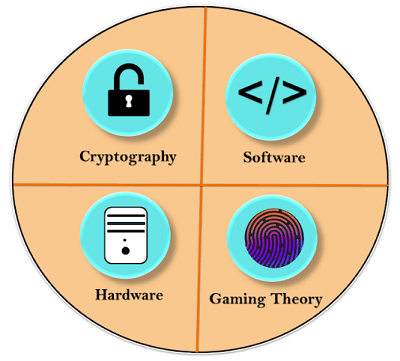Basic Component of Bitcoin
As we know that Bitcoin is a digital currency (cryptocurrency). It is a virtual currency or digital token, as well as it is a network on which all such digital tokens can be moved and stored.
Now let us learn about the components of Bitcoin. Learning the components will be helpful for us to understand the Bitcoin Blockchain better.
Here we will put everything we have learned into one scenario. We know that block consists or is made up of a complex cryptography environment & hash, but this all is just one part of the coin (one side). But the best part is Bitcoin Blockchain is fascinating.
Some basic terms which we need to know are-
- Encryption- Encryption means securing data so that the user needs to enter a code or password to decrypt it. & similar job is done by ciphering in cryptography.
- Wallet- A wallet is used to send, receive digital currencies, and store them. A Crypto wallet consists of received digital currencies.
- & some other basic terms you can go through are Nodes, Private key, Ask price, and Bid price.
The Basic Components of Bitcoin are -
- Software
- Cryptography
- Hardware
- Miners (Gaming Theory)
The following image shows all the components-

Software
Everything runs on software, and that software is Bitcoin software. Bitcoin is software at its heart (core) & it tells us what a Bitcoin is and how a Bitcoin can be transferred or gets transferred. It checks the validity of a Bitcoin, who can't be inside the Bitcoin, who can be inside the Bitcoin, what is not valid, what is valid etc. The Bitcoin software is always open (operated) every day.
Cryptography
As we know, cryptocurrency consists of Bitcoin & cryptography, and these two are known as the heart of software. Bitcoin uses encryption to transfer Bitcoins between different parties & even the generation of new Bitcoins. It would have never been possible to convince Bitcoin without cryptography. So we have developed the software that uses cryptography to control Bitcoin transfer throughout the internet. Cryptography can be solved by machines but not by people as it consists of a mathematical approach. Cryptography is essential to keep the data safe.
Hardware-
To solve & run cryptography requires very powerful hardware. This particular hardware is created especially for mining purposes. It is composed of many miners running their computers around the world.
Many computers are running or using Bitcoin clients or Bitcoin Software worldwide. The hardware is designed to help the miner find the Nonce & validate the hash & block. & this process requires a powerful machine & lot of CPU power to complete the tasks on the Bitcoin Blockchain.
If you mine with the help of your mobile (smartphone) or your laptop, you will damage your machines.
Gaming Theory (Mining)
Gaming theory is based on miners as they interact with the gaming theory. Bitcoin is a type of game itself that the miners worldwide manage. We saw the software component in the above section; the Bitcoin issues cryptography software confronts every ten minutes. The challenge produced by cryptography is to find out Nonce, which will help us to create a hash for a particular block. The work of miners here is to check the validation and hashes. After successfully creating a particular block, a new block is added to Blockchain.
Let us know how the Gaming theory works?
- Bitcoin software creates a challenge. There is a race which goes off, and the game begins. The race consists of miners competing with each other to solve particular challenges.
- This challenge usually takes around ten minutes to complete.
- The main aim of miners is to find the Nonce that will complete the hash for that particular block.
- The block that the winner mines will get verified by the whole community. Miners compete with themselves, and in the upcoming stages of the cycle, the rest of the community comebacks together to confirm that the answer or solution is correct. This property makes Bitcoin very strong because there are stages in Bitcoin and the 1st stage (one) of the cycle.
- It will create a new block which is further added to the Blockchain if the Nonce is correct.
- The prize for this is around 12.5 Bitcoins if the task is completed, and this prize is given to the winner.